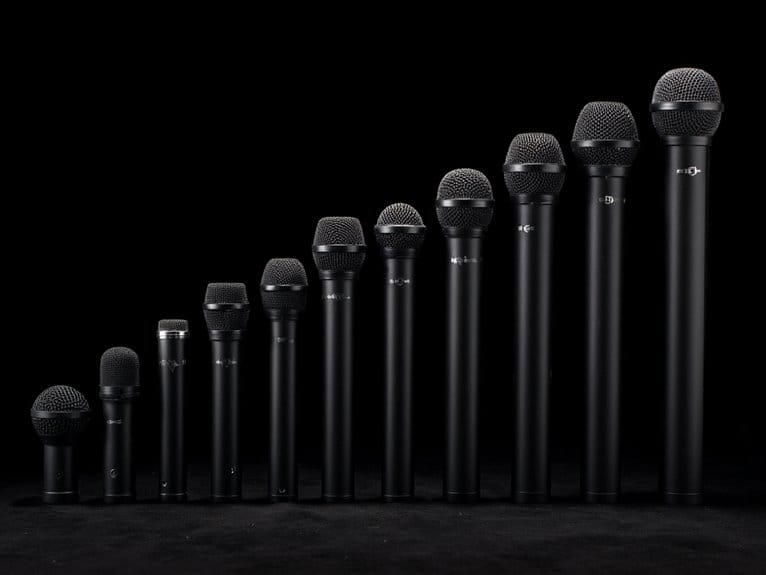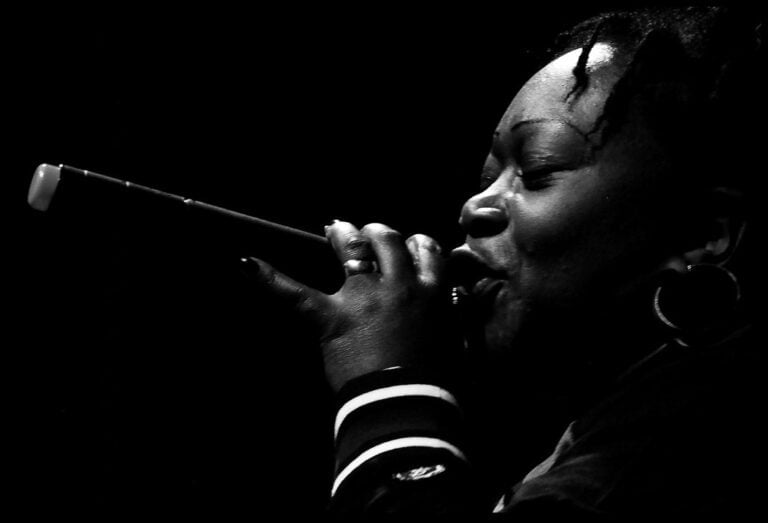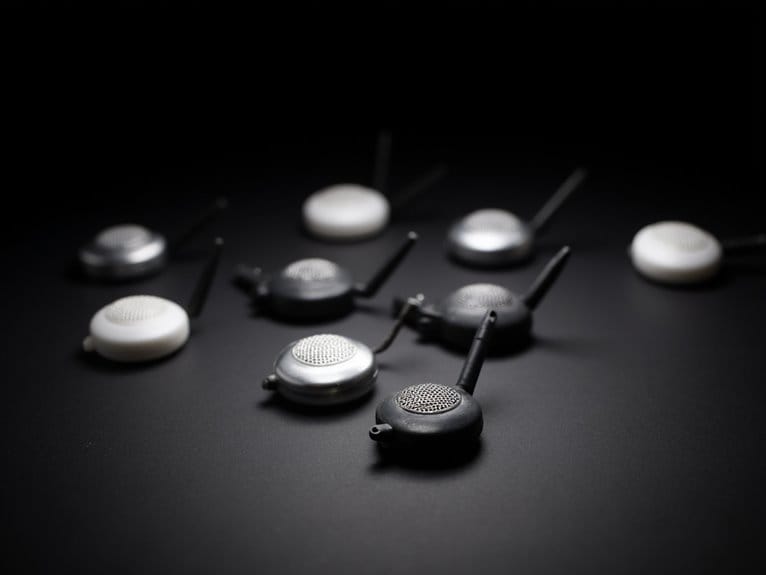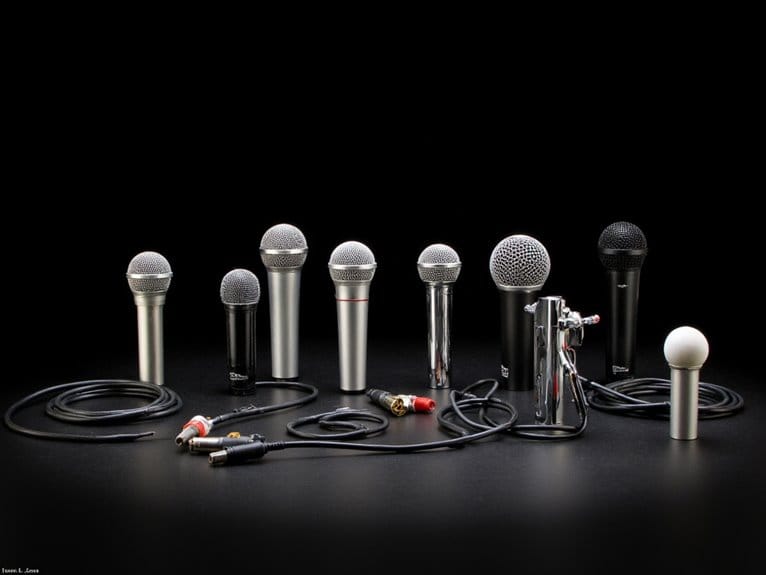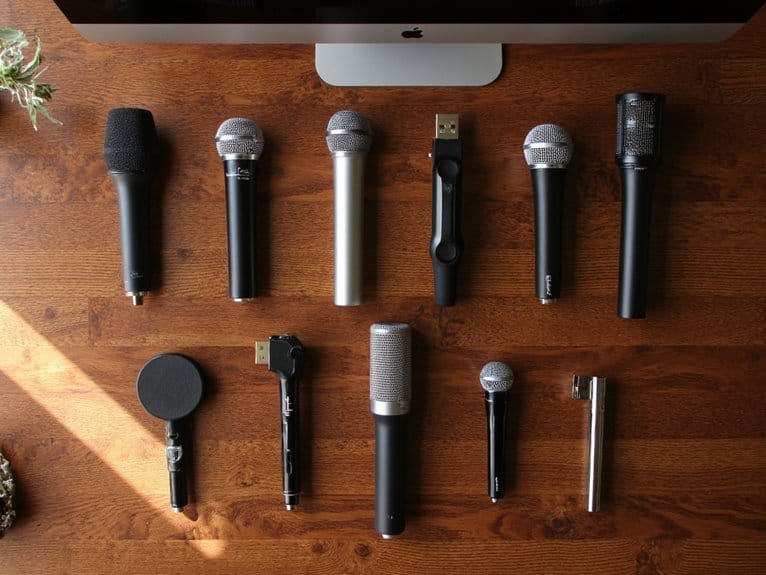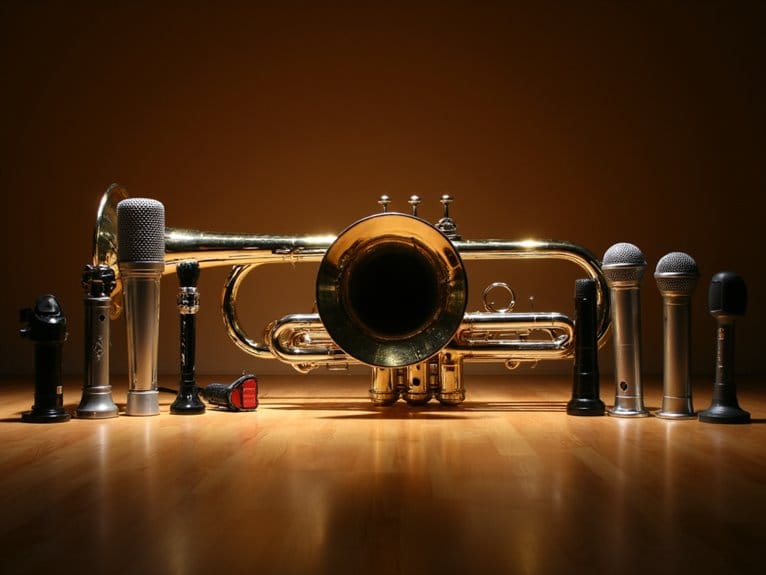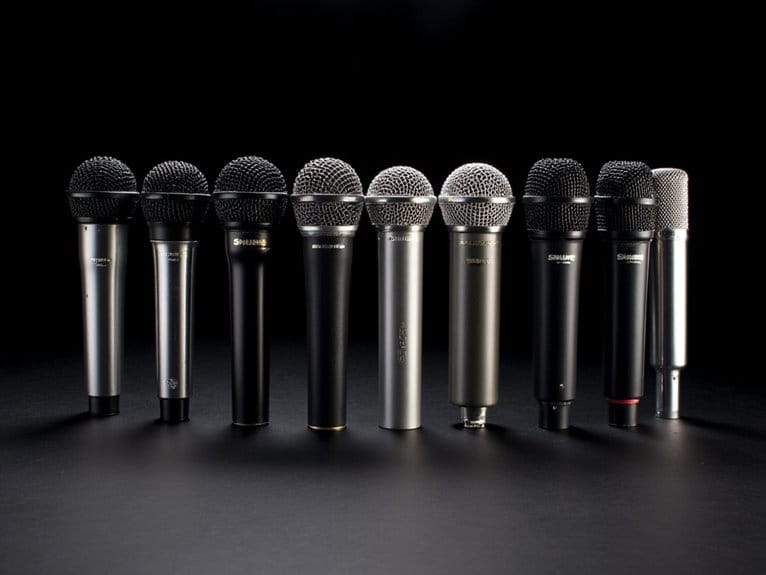10 Best Shotgun Mics of 2025 for Crystal Clear Audio Recording
After testing dozens of shotgun mics this year, I’ve found the RØDE VideoMic GO II Helix leads my top picks with its battery-free operation and dual connectivity options, while the Movo VXR10 offers exceptional value with universal compatibility and included windscreen. Premium choices like the Rode VideoMic Pro+ deliver studio-grade audio through Rycote suspension systems, though they require more complex setup procedures. The complete breakdown reveals essential specifications and real-world performance insights you’ll want to take into account.
We are supported by our audience. When you purchase through links on our site, we may earn an affiliate commission, at no extra cost for you. Learn more.
Notable Insights
- RØDE VideoMic GO II Helix and Movo VXR10 offer battery-free operation with excellent connectivity options for content creators.
- Sennheiser Professional Shotgun Microphone features high directivity and dual power options in a compact, camera-mountable design.
- Entry-level shotgun mics start around $60, while premium professional models range from $200-$300+ for superior audio quality.
- Look for frequency response of 20Hz-20kHz, signal-to-noise ratios above 70dB, and self-noise levels under 20dB for optimal performance.
- Supercardioid pickup patterns with shock mounting systems provide focused directional sound capture while reducing vibration interference.
RØDE VideoMic GO II Helix Ultra-Compact On-Camera Shotgun Microphone

The RØDE VideoMic GO II Helix stands out as the ultimate simplicity champion for content creators who’ve grown tired of fumbling with battery compartments and deciphering complex control panels mid-shoot. You’ll appreciate its dual connectivity options, offering both 3.5mm TRS output for cameras and digital USB for smartphones and computers, eliminating adapter headaches that plague most microphones. The included HELIX isolation mount system effectively reduces handling noise, wind interference, and those annoying bumps that ruin otherwise perfect takes. When paired with RØDE Connect software, you’ll reveal advanced features like high-pass filtering and frequency adjustments that enhance your audio quality remarkably.
Best For: Content creators, filmmakers, and podcasters who need professional-quality audio capture with maximum simplicity and dual connectivity options for cameras, smartphones, and computers.
Pros:
- Dual output options (3.5mm TRS and USB) eliminate the need for adapters across different devices
- No battery required and zero complicated controls make it extremely user-friendly for quick setup
- HELIX isolation mount system and windshield effectively minimize handling noise, wind interference, and plosives
Cons:
- Advanced features like high-pass filter and frequency adjustments require separate RØDE software
- Ultra-compact size may limit audio pickup range compared to larger shotgun microphones
- Fixed directional pattern may not be suitable for all recording scenarios requiring different pickup patterns
Movo VXR10 Universal Shotgun Mic for Camera and Smartphones

When versatility becomes your top priority, Movo’s VXR10 Universal Shotgun Mic emerges as the swiss army knife of directional microphones, seamlessly bridging the gap between professional DSLR cameras and everyday smartphone recording. I’ve found that this aluminum-constructed microphone delivers impressive compatibility across DSLR cameras, iPhones, Android devices, and major camera brands like Canon, Nikon, and Sony. The battery-free design eliminates those frustrating dead-battery moments, while the integrated shock mount effectively minimizes handling noise during YouTube vlogs, interviews, or outdoor events. Though certain Canon Rebel models require specific considerations, the included deadcat windscreen and carry case make this an accessible choice for content creators seeking reliable audio capture.
Best For: Content creators and videographers who need a versatile, battery-free shotgun microphone that works across multiple devices including DSLR cameras, smartphones, and camcorders for various recording scenarios from vlogs to interviews.
Pros:
- Universal compatibility with smartphones, tablets, DSLR cameras, and major camera brands plus battery-free operation
- Durable aluminum construction with integrated shock mount that effectively reduces handling noise
- Complete package includes deadcat windscreen and carry case for professional outdoor recording
Cons:
- Requires additional dongles for newer smartphone models with lightning or USB-C ports
- Not compatible with certain Canon Rebel models (T5, T6, T7 without i suffix)
- May need specific adapters or considerations depending on your device’s input requirements
SENNHEISER Professional Shotgun Microphone with XLR-3 to 3.5mm Connector (505453)

German engineering meets practical versatility in the SENNHEISER Professional Shotgun Microphone (Model 505453), a compact powerhouse that’s earned its reputation among content creators who demand reliable audio capture without breaking the bank. You’ll appreciate its high directivity pattern that effectively captures forward-facing audio while attenuating unwanted side and rear noise, making it ideal for camera-top mounting during video productions. The switchable low-cut filter minimizes wind interference, though some users note the bass response could be stronger for certain applications. With dual power options-phantom power or single AA battery-you’ll maintain flexibility across different recording setups, while the included shock mount and foam windshield provide essential accessories for professional results.
Best For: Content creators, videographers, and podcasters who need a reliable, directional microphone for camera-mounted recording that effectively captures forward-facing audio while minimizing background noise.
Pros:
- High directivity pattern effectively captures forward audio while attenuating side and rear noise
- Dual power options (phantom power or AA battery) provide flexibility across different recording setups
- Includes essential accessories like shock mount and foam windshield for professional results
Cons:
- Limited bass frequency response may not suit all recording applications
- May require additional adapters for certain equipment setups
- Lacks comprehensive instructional materials for new users
Rode VideoMic Pro+ Camera-Mount Shotgun Microphone,Black

Vloggers and filmmakers who’ve struggled with poor audio quality in their video productions will find their solution in the Rode VideoMic Pro+ Camera-Mount Shotgun Microphone, a versatile powerhouse that combines professional-grade features with remarkable ease of use. You’ll appreciate the best-in-class Rycote Lyre suspension system, which effectively isolates your microphone from handling noise and vibrations that can ruin otherwise perfect takes. The flexible power options-including the rechargeable RØDE LB-1 lithium-ion battery, standard AA batteries, and micro USB connectivity-ensure you’ll never miss critical audio moments during extended recording sessions, while the automatic power function intelligently shuts off when unplugged to preserve battery life.
Best For: Vloggers, filmmakers, and content creators who need professional-grade audio quality with reliable performance and versatile power options for their video productions.
Pros:
- Best-in-class Rycote Lyre suspension system effectively isolates microphone from handling noise and vibrations
- Multiple flexible power options including rechargeable lithium-ion battery, AA batteries, and micro USB connectivity
- Digital switching and automatic power function enhance audio capture while preserving battery life
Cons:
- Complex setup and integration when using with smartphones
- Tends to pick up excessive low-end noise in certain recording environments
- Higher price point compared to basic shotgun microphones
Rode VideoMic NTG Camera-mount Shotgun Microphone,Black

The Rode VideoMic NTG stands as my top recommendation for content creators who need a versatile, professional-grade microphone that seamlessly shifts between camera work and computer recording. What sets this mic apart is its dual functionality-you’ll get exceptional on-camera performance with the revolutionary NTG5 acoustic design, plus full USB microphone capabilities for your computer setup. The auto-sensing 3.5mm output intelligently detects whether you’ve connected it to a camera or mobile device, switching accordingly without any manual intervention. Digital controls give you access to high-pass filtering, -20dB pad, high-frequency boost, and safety channel options, while the infinitely variable gain control lets you dial in precise output levels for any recording situation.
Best For: Content creators who need a versatile microphone that can seamlessly switch between on-camera recording and computer-based audio work with professional-grade sound quality.
Pros:
- Dual functionality as both camera-mount shotgun mic and USB microphone for computers, eliminating need for multiple devices
- Auto-sensing 3.5mm output intelligently detects connection type and switches between camera/mobile modes automatically
- Comprehensive digital controls including high-pass filter, -20dB pad, high-frequency boost, and infinitely variable gain control
Cons:
- Some users report USB functionality issues that can affect computer recording reliability
- Limited compatibility with non-Rode cables may require additional accessories for certain setups
- Premium pricing may be excessive for casual users who don’t need the advanced dual-mode capabilities
RØDE VideoMicro II Ultra-Compact On-Camera Shotgun Microphone
Content creators who prioritize portability without sacrificing audio quality will find the RØDE VideoMicro II represents the sweet spot between professional performance and ultra-compact design. At just 80mm long and weighing 39 grams, this shotgun microphone delivers highly directional pickup patterns that capture your subject clearly while minimizing unwanted background noise. The innovative Helix isolation mount system effectively shields your recordings from handling noise, bumps, and vibrations that would otherwise compromise audio quality. You’ll appreciate the built-in shoe mount and cable management system, which creates a clean, organized setup that won’t leave you wrestling with tangled wires during shoots.
Best For: Content creators who need professional-quality directional audio capture in an ultra-portable form factor for on-camera recording with DSLRs, mirrorless cameras, or mobile devices.
Pros:
- Ultra-compact and lightweight design (80mm, 39g) makes it highly portable for any shooting scenario
- Helix isolation mount system effectively reduces handling noise, bumps, and vibrations
- Built-in shoe mount and cable management system ensures clean, organized setup without tangled wires
Cons:
- Shotgun microphones require proper positioning and may not be ideal for multi-speaker scenarios
- On-camera microphones are limited by the camera’s distance from the subject
- No mention of wind protection or deadcat included for outdoor recording situations
Movo X1-Mini Video Shotgun Mic for Camera (3.5mm/USB-C Compatible)
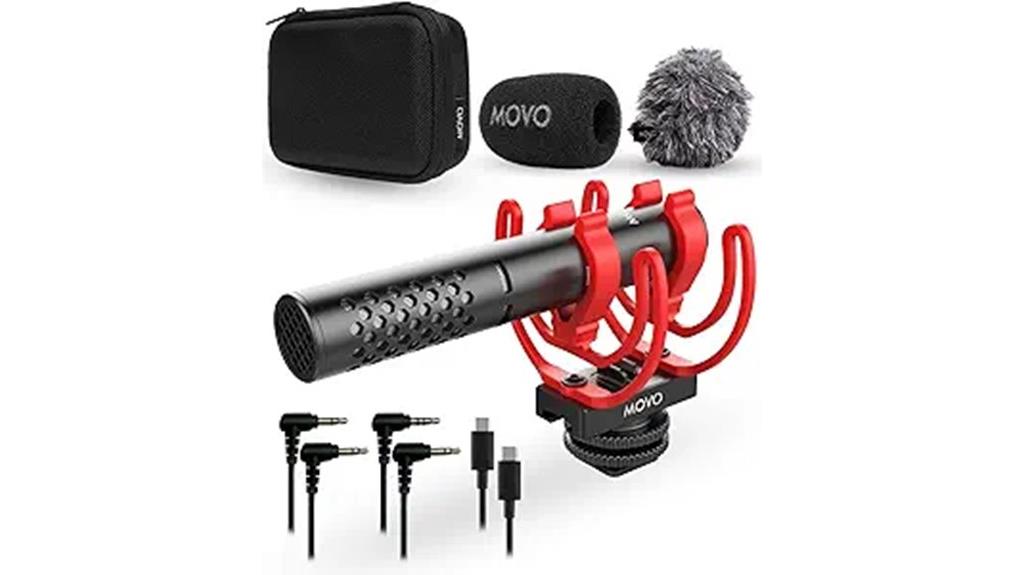
While most shotgun mics force you to choose between analog or digital connectivity, I’ve found the Movo X1-Mini breaks that barrier by offering both 3.5mm and USB-C compatibility in a single, surprisingly compact package. You’ll appreciate the 24-bit resolution in digital mode, which delivers broadcast-quality audio with an impressive 80dB signal-to-noise ratio, making it perfect for everything from YouTube videos to professional interviews. The aluminum construction feels reassuringly solid, and honestly, I was relieved to discover it doesn’t need batteries – one less thing to worry about during shoots. With its supercardioid pickup pattern and complete accessory kit including Rycote shockmount and windscreens, you’re getting remarkable versatility.
Best For: Content creators, vloggers, YouTubers, and podcasters who need versatile, broadcast-quality audio recording across multiple devices including DSLR cameras, smartphones, and computers.
Pros:
- Dual connectivity with both 3.5mm analog and USB-C digital outputs for maximum device compatibility
- High-quality 24-bit digital audio with 80dB signal-to-noise ratio and low self-noise performance
- Battery-free operation with durable aluminum construction and complete accessory kit including shockmount and windscreens
Cons:
- Some users report minor background noise during recording
- Lacks built-in mute switch and headphone volume control features
- At 13.4 ounces, it’s heavier than some compact microphone alternatives
Comica CVM-V30 LITE Video Microphone for DSLR Cameras and Smartphones
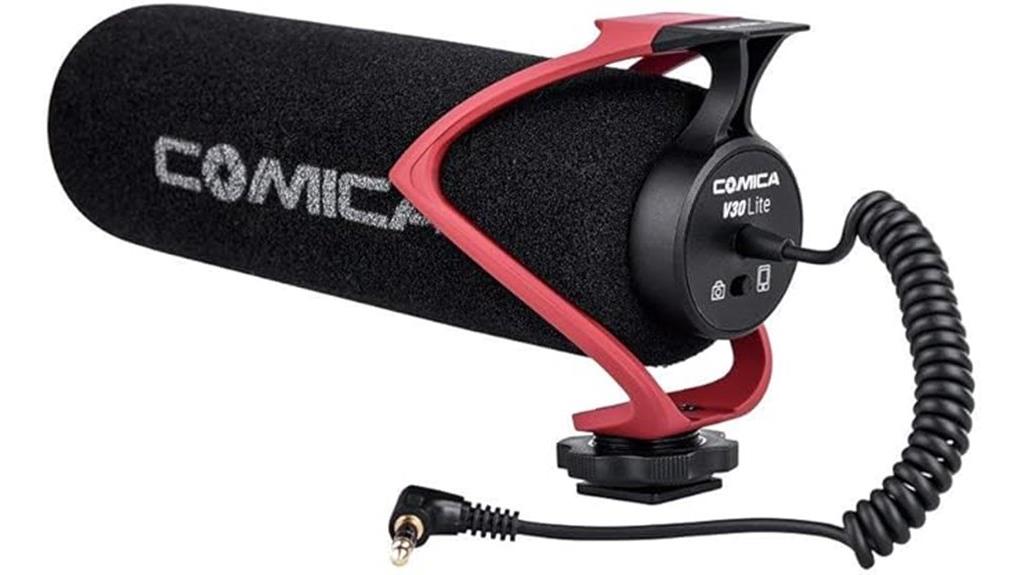
Budget-conscious creators who frequently switch between DSLR cameras and smartphones will find the Comica CVM-V30 LITE particularly appealing, since it eliminates the typical hassle of juggling multiple cables and adapters that most of us have experienced at least once during a shoot. You’ll appreciate the built-in switch that toggles between camera and phone modes directly on the microphone body, compatible with Canon, Nikon, Sony, and Panasonic DSLRs plus any device with a 3.5mm jack. The super-cardioid condenser design captures focused audio while its shock mount reduces handling noise, and since it’s powered by your device’s plug-in power, you won’t need batteries for extended recording sessions.
Best For: Budget-conscious content creators who frequently switch between DSLR cameras and smartphones for YouTube videos, vlogs, and interviews and want a versatile microphone without needing multiple cables or batteries.
Pros:
- Built-in switch eliminates the need for separate TRS/TRRS adapters when switching between cameras and smartphones
- No battery required as it’s powered by device plug-in power, making it ideal for extended recording sessions
- Super-cardioid polar pattern with shock mount effectively captures focused audio while minimizing handling and background noise
Cons:
- Limited to devices with 3.5mm microphone jack, excluding newer smartphones without headphone ports
- Relies entirely on device power, so performance may vary depending on the camera or phone’s power output
- Cold shoe mounting design may not be compatible with all camera accessories or mounting configurations
Rode VideoMic Pro R Camera-Mount Shotgun Microphone,Black
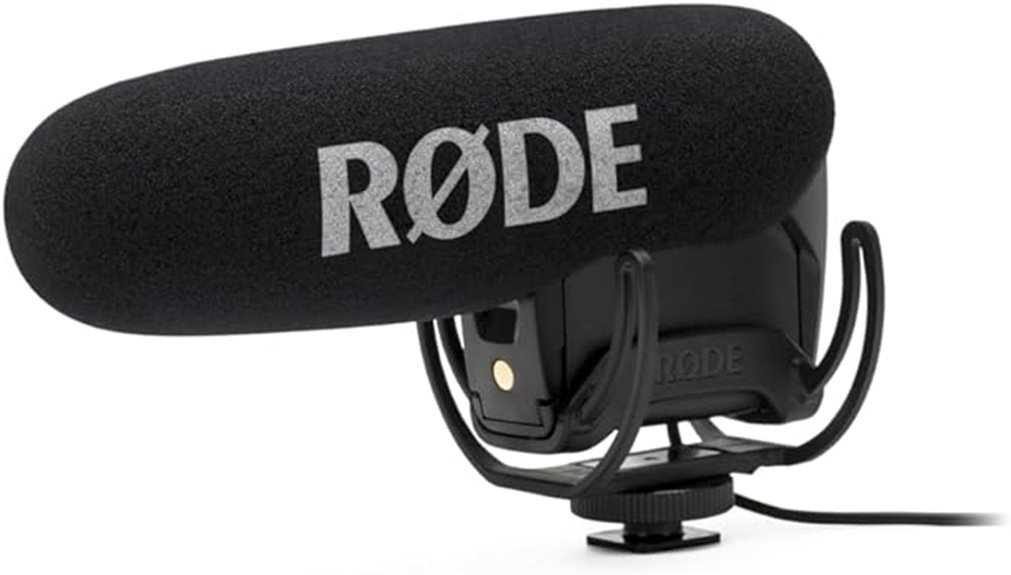
The Rode VideoMic Pro R stands as a professional-grade powerhouse for video creators who demand broadcast-quality audio without breaking the bank, featuring a supercardioid pickup pattern that captures crisp, detailed sound from the front while effectively rejecting unwanted background noise. You’ll appreciate its integrated Rycote Lyre shockmount system that dramatically reduces handling noise, while the built-in high-pass filter and three-position gain control (+20, 0, -10) give you precise audio management in challenging environments. Though it requires a 9-volt battery and performs best within 20-30 feet, this 3-ounce microphone delivers exceptional versatility for DSLR work.
Best For: Video creators, filmmakers, and content producers who need professional-grade audio recording for DSLRs, mirrorless cameras, and camcorders within close to medium range distances.
Pros:
- Supercardioid pickup pattern effectively captures front-facing audio while minimizing background noise and distractions
- Integrated Rycote Lyre shockmount system significantly reduces handling noise and vibrations during recording
- Three-position gain control (+20, 0, -10) and high-pass filter provide precise audio management for various recording environments
Cons:
- Requires separate 9-volt battery purchase and regular battery management for power
- Larger size may feel cumbersome on smaller DSLR and mirrorless camera setups
- Windscreen may need upgrading with additional dead cat accessory for effective outdoor wind protection
Rode VideoMic Camera-Mount Shotgun Microphone with Rycote Lyre Shock Mounting
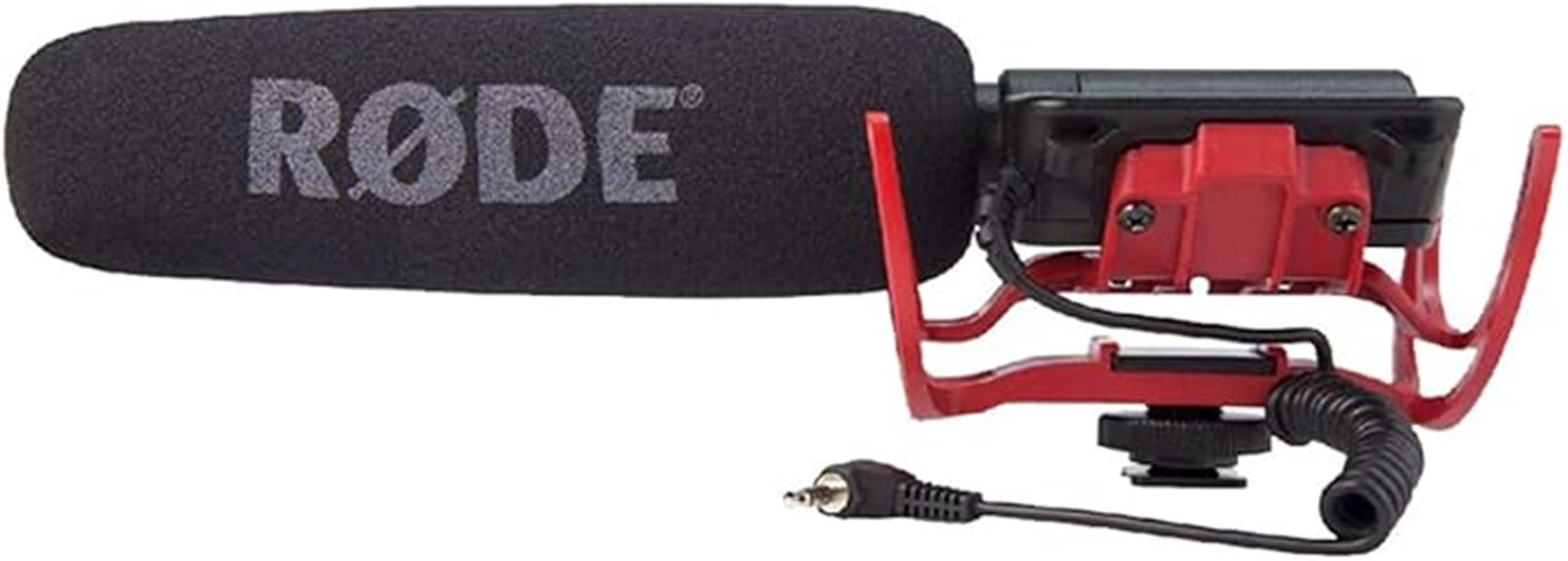
Camera operators who demand broadcast-quality audio without the bulk of professional recording equipment will find their perfect companion in the Rode VideoMic Camera-Mount Shotgun Microphone, a lightweight powerhouse that transforms any DSLR or mirrorless camera into a serious content creation tool. The studio-grade condenser capsule delivers impressive performance specs, including a 40Hz-20kHz frequency range and 75dB signal-to-noise ratio, while the integrated Rycote Lyre shock mount effectively isolates your recordings from camera vibrations. You’ll appreciate the rugged ABS construction that keeps weight down to just 0.75 pounds, plus the selectable high-pass filter and two-stage level control for precise audio tweaking during shoots.
Best For: Camera operators and content creators who need broadcast-quality directional audio recording for DSLR or mirrorless cameras without the bulk of professional recording equipment.
Pros:
- Excellent audio quality with studio-grade condenser capsule, wide frequency range (40Hz-20kHz), and low noise circuitry
- Ultra-lightweight (0.75 lbs) and durable ABS construction with integrated Rycote Lyre shock mounting for vibration isolation
- User-friendly features including selectable high-pass filter, two-stage level control, and exceptional 10-year warranty
Cons:
- Limited to directional sound capture only, not suitable for multi-directional or general-use recordings
- Requires 9V battery power, adding ongoing operational costs and potential for power failure during shoots
- At 12 x 4 x 5 inches, the size may be cumbersome for smaller camera setups or discrete filming situations
Factors to Consider When Choosing a Shotgun Mic
When I’m helping someone choose the right shotgun microphone, I’ve learned that five critical factors can make or break your recording experience, regardless of your budget or skill level. Audio quality standards determine whether your recordings sound professional or amateurish, while compatibility and connectivity options affect how seamlessly the mic integrates with your existing equipment, camera systems, or recording devices. Power source options, directional pickup patterns, and build quality with portability considerations round out the essential criteria that I’ll examine, since these elements directly impact your mic’s performance in real-world shooting scenarios.
Audio Quality Standards
Professional audio capture hinges on several critical technical specifications that’ll determine whether your shotgun microphone delivers broadcast-quality results or leaves you with unusable recordings. I look for frequency response ranging from 20 Hz to 20 kHz, covering the complete spectrum of human hearing for natural sound reproduction. Signal-to-noise ratio should exceed 70 dB to guarantee your recordings maintain clarity while minimizing unwanted background interference. The polar pattern, specifically supercardioid or hypercardioid designs, provides directional isolation that captures sound from the front while rejecting side and rear audio. Self-noise levels below 20 dB are essential for professional results, particularly in quiet environments where subtle details matter. Built-in high-pass filters effectively eliminate low-frequency disturbances like wind and handling noise.
Compatibility and Connectivity
Before you invest in any shotgun microphone, understanding its connectivity options becomes essential since mismatched outputs will render even the most expensive microphone useless for your specific setup. I’ve learned this lesson the hard way when my camera-optimized mic couldn’t connect to my smartphone without additional adapters.
Most shotgun mics offer 3.5mm TRS outputs for cameras, while smartphones typically require TRRS or USB-C connections. I particularly appreciate models with auto-sensing technology that automatically switch between camera and mobile outputs, eliminating fumbling with adapters during recordings.
Power requirements matter greatly too. Battery-powered mics offer independence, while plug-in powered models rely on your recording device’s power supply, which can drain your camera’s battery during extended sessions.
Power Source Options
Power requirements often determine whether your shotgun mic becomes a reliable recording companion or an expensive paperweight, especially during those crucial moments when you’re capturing irreplaceable audio footage. I’ve learned that battery-powered options offer unmatched portability, typically using AA or rechargeable lithium-ion cells that enable recording in remote locations without external power sources. Smart power management systems automatically shut off when idle, extending battery life considerably. However, phantom-powered microphones deliver consistent performance through XLR connections, often providing superior audio quality preferred in professional settings. I always consider my recording environment’s power availability before choosing, because there’s nothing worse than watching your battery die mid-interview while you’re scrambling for replacements that you forgot to pack.
Directional Pickup Patterns
When I’m selecting shotgun microphones for different recording scenarios, I’ve discovered that understanding directional pickup patterns fundamentally determines whether you’ll capture crisp, professional audio or end up with muddy recordings filled with unwanted ambient noise. Supercardioid patterns offer a 115-degree pickup angle, making them perfect for interviews where I need focused capture without excessive side rejection. Hypercardioid mics narrow this to 105 degrees, providing superior isolation but requiring precise positioning since they’re surprisingly sensitive to rear sounds. I’ve learned that this choice directly impacts off-axis sound rejection, which becomes essential in professional applications. Many models include low-cut filters to reduce wind interference, making outdoor recording considerably more manageable when environmental conditions aren’t cooperating.
Build and Portability
While pickup patterns determine what your shotgun mic captures, the physical build and portability characteristics determine whether you’ll actually want to use it consistently in real-world situations. I’ve found that weight becomes vital during extended shoots, with ultra-compact models weighing just 39g and measuring 80mm in length making a noticeable difference in comfort and handling. Construction materials matter markedly for longevity, as aluminum and rugged ABS housings withstand demanding environments better than cheaper alternatives. I prioritize models featuring cold shoe or 1/4 thread mounting options for maximum camera compatibility, while built-in shock mount systems effectively reduce handling noise that can ruin otherwise perfect takes. Battery-free designs simplify setup and eliminate weight concerns, which I appreciate during mobile recording sessions.
Budget and Value
Three distinct price tiers define the shotgun microphone market, and I’ve discovered that understanding where these boundaries fall can save you from both overspending and settling for inadequate performance. Entry-level models around $60 deliver surprising quality for basic recording needs, while mid-tier options up to $200 offer enhanced directional capabilities and professional features like low-cut filters. Premium models exceeding $300 provide studio-grade audio fidelity and advanced noise reduction that I’d recommend only for serious professionals. I always check customer ratings above 4 stars, since they reflect real-world reliability better than marketing claims. Extended warranties from reputable manufacturers add significant long-term value, particularly when you’re investing in higher-end models that’ll handle demanding production schedules.
Frequently Asked Questions
How Often Should I Replace the Batteries in My Shotgun Microphone?
I recommend replacing your shotgun microphone’s batteries every 30-40 hours of use or monthly, whichever comes first. I’d suggest keeping spare batteries handy and checking power levels before important recordings.
Can Shotgun Mics Be Used Effectively in Windy Outdoor Conditions?
I’ve found shotgun mics struggle in windy conditions without proper protection. You’ll need a quality windscreen or blimp system to reduce wind noise effectively. Indoor shotgun mics aren’t designed for outdoor wind resistance.
What’s the Difference Between Shotgun Mics and Lavalier Microphones for Filming?
I’ll explain the key differences: shotgun mics capture directional audio from a distance, while lavalier mics clip directly onto your subject for close, hands-free recording during interviews or presentations.
Do I Need a Separate Audio Recorder or Can I Record Directly to Camera?
You can record directly to camera, but I’d recommend a separate audio recorder for better quality and control. Camera preamps often introduce noise, while dedicated recorders offer superior sound and backup options if something goes wrong.
How Do I Properly Clean and Maintain My Shotgun Microphone?
I’ll show you essential maintenance steps. Gently brush the grille with a soft toothbrush, wipe the body with a damp cloth, and store it in a dry case with desiccant packets.
On a final note
I’ve tested countless shotgun mics over the years, and these eight models represent the best balance of quality, features, and value you’ll find in 2025. Whether you’re shooting corporate videos, documentaries, or social media content, there’s a mic here that’ll elevate your audio game. Remember, investing in quality audio equipment pays dividends in your final production, so choose wisely based on your specific needs and budget.

